Life Science
-

-

Developmental Biology
Pages: 711,
Specialty: Life Science,
Publisher: Sinauer,
Publication Year: 2010,
Cover: Hardback,
Dimensions: 222x285x32mm
During the past four years, the field of developmental biology has begun a new metamorphosis. The Ninth Edition of Developmental Biology mirrors this shift with a wholly revised text, over 600 new literature citations, and substantial reorganization of content. The introductory section has been streamlined from six chapters to three-one each on developmental anatomy, the mechanisms of gene regulation during differentiation, and cell-cell communication during morphogenesis. Another new feature is the addition of short part openers that address key concerns in developmental biology. These provide an introduction to the subsequent chapters, telling the reader what to expect and placing that information into a specific context. Each chapter ends with a guide to Web-based resources relevant to that chapter's content, and the Ninth Edition is the first to include a glossary of key terms. Some of the new material in this edition includes: mesenchymal and induced pluripotent stem cells; the transdifferentiation of pancreatic cells; new data on sea urchin micromere specification; the mechanisms whereby Sry and Wnt signaling determine mammalian sex; the memory of cell fate during amphibian limb regeneration; how bats got their wings and how dachshunds got their short legs. This completely updated text includes fundamental new material that alters what we teach in developmental biology courses. Included inside every new copy of the book is an online access code for Mary Tyler and Ron Kozlowski's remarkable resource, DevBio Laboratory: Vade Mecum3. (Online access may also be purchased separately.) The book also offers a Companion Website (www.devbio.com). Cross-referenced throughout the textbook, this resource provides more information for advanced students, historical, philosophical, and ethical perspectives on issues in developmental biology, videos, interviews, Web links, and updates. The website includes the full bibliography of literature cited in the book, most of which are linked to their PubMed citations. Also, for the Ninth Edition, Susan Singer's chapter on plant developmental biology has been moved to this location.show more
Weight: 1.89 KG
Learn MoreKWD9.00 -

-
 KWD4.50
KWD4.50 -

-
 KWD5.40
KWD5.40 -

Environmental DNA For Biodiversity Research and Monitoring
Pages: 272,
Specialty: Life Science,
Publisher: Oxford UP,
Publication Year: 2018,
Cover: Paperback,
Dimensions: 190x248x13mm
Environmental DNA (eDNA) refers to DNA that can be extracted from environmental samples (such as soil, water, feces, or air) without the prior isolation of any target organism. The analysis of environmental DNA has the potential of providing high-throughput information on taxa and functional genes in a given environment, and is easily amenable to the study of both aquatic and terrestrial ecosystems. It can provide an understanding of past or present biological communities as well as their trophic relationships, and can thus offer useful insights into ecosystem functioning. There is now a rapidly-growing interest amongst biologists in applying analysis of environmental DNA to their own research. However, good practices and protocols dealing with environmental DNA are currently widely dispersed across numerous papers, with many of them presenting only preliminary results and using a diversity of methods. In this context, the principal objective of this practical handbook is to provide biologists (both students and researchers) with the scientific background necessary to assist with the understanding and implementation of best practices and analyses based on environmental DNA. show more
Weight: 0.58 KG
Learn More -

Environmental Plant Physiology
Pages: 160,
Specialty: Life Science,
Publisher: Taylor & Francis,
Publication Year: 2016,
Cover: Paperback,
Dimensions: 134x210x12mm
Plant physiology - the structure of plants- is often perceived as complex and difficult. Yet it need not be. In this comprehensive yet concise guide, we tackle topics in straightforward bite-sized chunks, consolidating each one before moving on to the next. This will save you valuable revision time by helping you to learn more easily and quickly and tackle coursework and examinations with greater confidence. There are 'tutorials' at the end of each chapter to help you improve your learning with practice questions, discussion points, practical assignments and study and revision tips. It is complete with a glossary, a guide to web sites for biology students and a detailed index. This new edition of this book has been specially written for students wanting a clear and concise introduction to this fast-developing field, whether for A and AS Level core and modular courses in Biology, Human Biology and Social Biology, or for first year degree courses in life sciences. It will also be of interest to agriculture and horticulture students and medical and microbiology students.This book explains: water uptake, photosynthesis, respiration, Enzymes and metabolism control, solute transport , plant movements.
Weight: 0.24 KG
Learn MoreKWD14.10 -

-

Essential Forensic Biology Animals Plants and Microorganisms in Legal Investigation
Pages: 304,
Specialty: Life Science,
Publisher: Wiley,
Publication Year: 2007,
Cover: Hardback,
Dimensions: 167.6x246.4x17.8mm
"Essential Forensic Biology" is an introduction to the application of the science of biology in legal investigations. Focusing on the legal system in the UK, the book provides a detailed description of the decay process, and discusses the role of forensic indicators - human fluids and tissues, including blood cells, bloodstain pattern analysis, hair, teeth, bones and wounds. It also considers the role microorganisms, invertebrates and plants play within forensic investigations before considering future directions in forensic science. The book examines the study of forensic biology in cases of suspicious death, and also explores the organisms used in a range of legal investigations; from human and animal neglect to food spoilage, structural damage, the illegal collection/trade of protected species and bioterrorism."Essential Forensic Biology" fills the gap for a resource, which provides information on the range of biological organisms; animals, plants and microbes used in forensic studies. An invaluable introductory text for all students taking forensic science courses, the book features a fully integrated website that covers forensic entomology with additional material and figures from the text to enhance student understanding. The features include: an introduction covering the essentials of forensic biology; features a fully integrated website covering forensic entomology with additional material and self-test questions to reinforce student understanding; each chapter includes a series of questions and topics for further study; and focuses on the UK legal system. From the reviews: "...the numerous black and white photographs, drawings and tables within the book are clear and well deployed." - "Times Higher Education Supplement", 23rd February 2007.show more
Weight: 0.7 KG
Learn MoreKWD9.00


